Pros
Cons
Introduction
Product Overview
{{section_header}}{{section.name}}{{/section_header}}
Get to know the California Headphone Co.'s Laredo headphones.
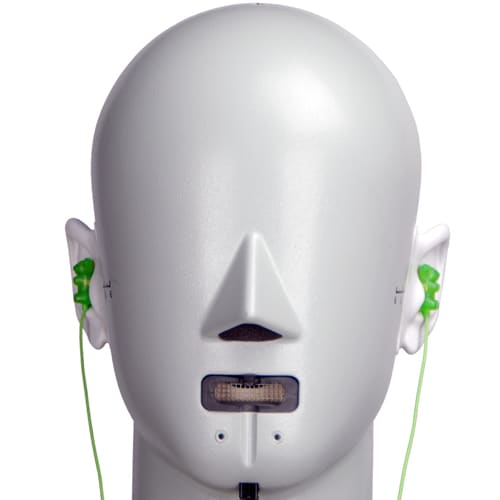
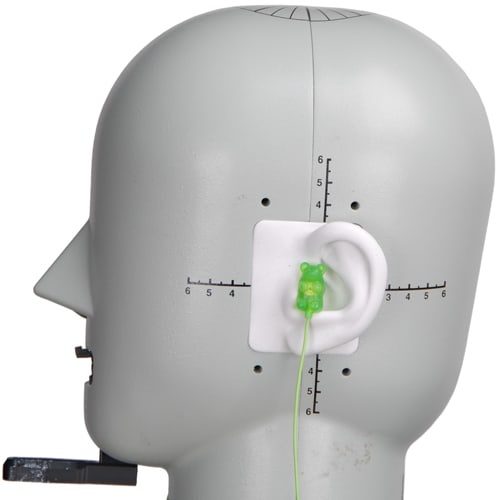
Speakers
{{section_header}}{{section.name}}{{/section_header}}
With the ear pad and the mesh removed, the speaker element of the {{product.name}} looks quite bare, but we can see some of the internal workings of the headphone.
Back
{{section_header}}{{section.name}}{{/section_header}}
Sporting a tinted brushed metal, the backs of the {{product.name}}s are quite pretty to look at, even if they're a bit on the simple side.
Band
{{section_header}}{{section.name}}{{/section_header}}
The metal band of the {{product.name}} is wrapped in a black, stitched, leather to more softly cradle your cranium.
Cable
{{section_header}}{{section.name}}{{/section_header}}
Not your standard, boring, black affair, the cloth-wrapped cable of the {{product.name}}s is fairly robust. You're not likely to snap it. Measuring in at 3.93 feet long, it is only punctuated by one super-secret bonus feature: an extra jack for your friends to plug into.
The cable of the {{product.name}}s terminates in a perfectly ubiquitous 1/8th inch plug.
Despite having a robust cable, the cord guards to the {{product.name}} are actually not all that strong. Do what you can to baby the solder points of your headphones.
Additional Features
{{section_header}}{{section.name}}{{/section_header}}
Here's the extra plug we mentioned earlier: if you want to share a source with a friend, all they have to do is plug their headphones into yours, and viola! you are both now listening to the same source.
In the Box
{{section_header}}{{section.name}}{{/section_header}}
Your {{product.name}}s come packaged with assorted documentation, and about nothing else.
Durability
{{section_header}}{{section.name}}{{/section_header}}
It's true that metal-cased headphones are probably not going to suffer as much damage as their plastic-ensconced brethren, but the {{product.name}}s have a couple things you should be aware of. For example, in the rather unlikely event that you manage to break the cable or a solder point, you can't replace it: your headphones are dead.
Aesthetics
{{section_header}}{{section.name}}{{/section_header}}
If you're a fan of tinted brushed metal, these headphones will definitely tickle you. With a sleek construction and a bit of a vintage feel, the {{product.name}}s are very attractive.
Frequency Response
{{section_header}}{{section.name}}{{/section_header}}
For the most part, the frequency response of the {{product.name}}s are actually quite decent, until you get to a really bizarre muting at about 3kHz.
We're not entirely sure what could possibly be the cause of the error, as we've tested these cans 10+ times. It's always there. We tried reaching out to California Headphone Co. and received no answer. Our best guess is that this particular pair may have something wrong with it, or that something is touching the drivers on the inside. Either way, while most of your music will sound okay, there will be a few instances where you can't help but notice a gap in some sounds, and the effect is jarring.

Click here for more information on our frequency response test.
Distortion
{{section_header}}{{section.name}}{{/section_header}}
Right at that 3kHz mark, we see a rather significant spike in distortion, but a relatively okay performance all around only if you ignore that.
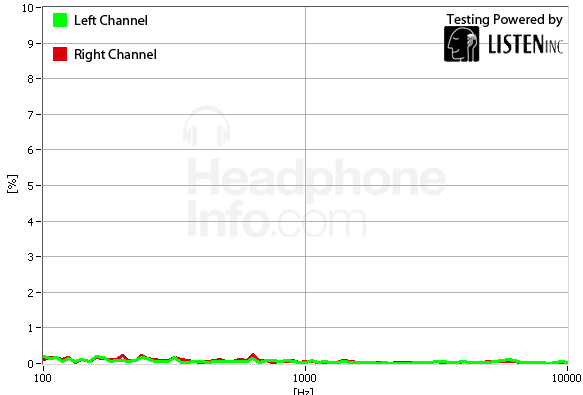
Click here for more information on our frequency response test.
Tracking
{{section_header}}{{section.name}}{{/section_header}}
Here is where the results just get ugly. With wild shifts in preference from one speaker to the other, the errors in your music will be very noticeable and distracting, especially in the high end.
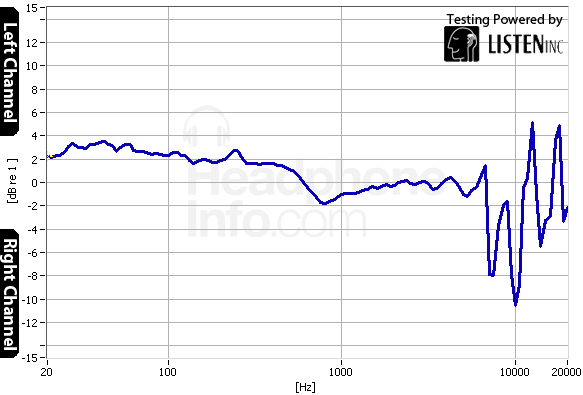
Click here for more information on our frequency response test.
Isolation
{{section_header}}{{section.name}}{{/section_header}}
For all their shortcomings in other areas, the {{product.model}} actually block out a considerably high amount of outside noise in comparison to most other on-ear headphones. Not only do they cut out high-end noise like car horns and the like, but they also manage to block out a tad more low-end sounds like car engines. Very cool.

Click here for more information on our isolation test.
Leakage
{{section_header}}{{section.name}}{{/section_header}}
Because they are very good at making a seal, the {{product.model}} really don't annoy those around you with your music, so go nuts on the volume. You know, at least within reason.
Click here for more information on our leakage test.
Maximum Usable Volume
{{section_header}}{{section.name}}{{/section_header}}
While your iPod or smartphone is unlikely to be able to bump your tunes at the {{product.model}}'s max SPL of 113.65dB, we would like to take this opportunity to point out that if you listen to your music at a high volume, you're very likely to damage your hearing.
Click here for more on our maximum usable volume test
Short-Term Use
{{section_header}}{{section.name}}{{/section_header}}
Once you slide the {{product.model}} on your head, you'll enjoy the soft leather cupping your pinna, and not suffer from excessive clamping. Few, if any, comfort problems were reported from those with differently-sized heads, but comfort is largely subjective, so see if you can find a pair of these to try on if you're unsure about purchasing them.

Extended Use
{{section_header}}{{section.name}}{{/section_header}}
Over time, the fit of the {{product.model}}s really doesn't change that much, so what you feel when they first cradle your noggin is basically what you can expect for the rest of your listening session.
Customizability
{{section_header}}{{section.name}}{{/section_header}}
Due tot he fact that the {{product.model}} really don't have any options for changing anything about your headphones, they don't score so well in terms of customizability. That's not inherently a bad thing, because many people just want a set of headphones, and don't really care if you can put new faceplates on there, or swap out a bunch of accessories.
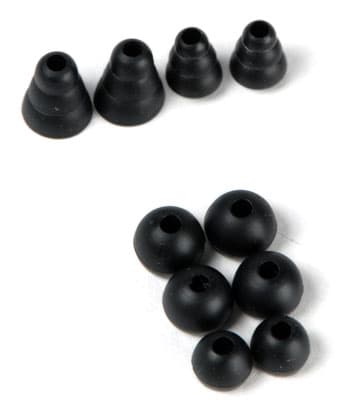
Cable Connectivity
{{section_header}}{{section.name}}{{/section_header}}
With a standard 1/8th inch plug, you'll be able to use your {{product.model}} with a smartphone or media player no sweat. This plug also means that the {{product.model}} wasn't really built with an amplifier or older hi-fi set in mind, but if you're looking to connect these cans to a mobile device, you're all set.
Portability
{{section_header}}{{section.name}}{{/section_header}}
Despite the fact that the {{product.model}} are a little on the large side for portable headphones, they can be taken out and about with reasonable allowance for bulk. While we don't recommend you shove them just anywhere, they'd fit well in a messenger bag or backpack if you need to stow them.
Maintenance
{{section_header}}{{section.name}}{{/section_header}}
Aside from wiping down the protective mesh over the speaker element, there really isn't a whole lot you can do to maintain your cans. It's not surprising, really, as very few headphones under $100 have many features that allow you to destroy and rebuild your cans.
Other Features
{{section_header}}{{section.name}}{{/section_header}}
Most of the way down the cable is an auxiliary jack that allows you to share your music with a friend if they have headphones of their own. All they have to do is plug in, and they can listen in on whatever you have on at the moment. If you're into sharing your music with your friends, this is a useful feature if you don't want to buy and subsequently lose a headphone jack splitter.
Design
{{section_header}}{{section.name}}{{/section_header}}
For a bit more money, you can pick up Skullcandy's Aviators, which are designed to look very much like the sunglasses of the same name. However, there is one huge drawback: while they can be used as a smartphone headset, they are also made of very cheap plastic in contrast to the {{product.model}}s' all-metal housing.
Frequency Response
{{section_header}}{{section.name}}{{/section_header}}
If it weren't for the ~3kHz muting problem the {{product.model}}s seem to have, the Aviators might have been outclassed, but as it stands, the {{product.model}}s just don't stack up well.
Distortion
{{section_header}}{{section.name}}{{/section_header}}
The Aviators win this one handily, as they do not have the odd spikes in distortion that the {{product.model}}s do.
Tracking
{{section_header}}{{section.name}}{{/section_header}}
Same here: even having a merely passable tracking response is better than a wildly erratic one.
Isolation
{{section_header}}{{section.name}}{{/section_header}}
If you're looking for a set of cans that blocks out a bunch of noise, the {{product.model}}s are great at it: better than the Aviators.
Comfort
{{section_header}}{{section.name}}{{/section_header}}
While there is a large difference between how on-ears and over-ears feel, this is one you're going to have to determine for yourself. Both have soft leather, and both cup your ear gently. See if you can't head to a store if you're really curious about how they'll feel, but both are very comfortable for most.
Verdict
{{section_header}}{{section.name}}{{/section_header}}
While the audio performance of the Aviators is very good, users who are more concerned with durability or noise attenuation will probably want to pick up the {{product.model}}s. Both sets of cans are at a similar price point, so what makes either set of headphones "better" for you relies more in what you want your headphones to do; if you want a headset, get the Aviators, if you want the brushed metal look and attenuation, get the {{product.model}}.
Design
{{section_header}}{{section.name}}{{/section_header}}
By design, the {{product.name}}s are much different than the Sennheiser HD 280 Pros. For example, they're made out of metal, and the HD 280 Pros are made of a clunky thick plastic. As pictured, the {{product.name}} are also well-polished from an aesthetic standpoint, and the Sennheiser cans are rather ugly.
Frequency Response
{{section_header}}{{section.name}}{{/section_header}}
Due to egregious errors in tracking for both sets of headphones, both are rather unimpressive in the frequency response department, but the response of the {{product.model}}s is better for a wider range of frequencies, with that one huge blemish.
Distortion
{{section_header}}{{section.name}}{{/section_header}}
Neither does well with distortion here, but the HD 280 Pros are technically better.
Tracking
{{section_header}}{{section.name}}{{/section_header}}
Both sets of headphones have fairly terrible tracking, with several prominently noticeable errors that you will hear.
Isolation
{{section_header}}{{section.name}}{{/section_header}}
While neither is bad at isolation, the {{product.model}} cans block out a wider range of outside noise.
Comfort
{{section_header}}{{section.name}}{{/section_header}}
The {{product.model}}s should be a bit more comfortable for a wider range of people, as the band to the Sennheiser HD 280 Pros is quite tight on those of us with bigger brain-cages. If you have a smaller head, this may not be as big of an issue, however.
Verdict
{{section_header}}{{section.name}}{{/section_header}}
While both of these headphones perform towards the lower end of entry level, if you're forced to choose, the {{product.model}}s seem to hold the advantage in durability and compatibility with mobile devices, as they have a lower impedance and higher sensitivity.
Design
{{section_header}}{{section.name}}{{/section_header}}
From a functional design standpoint, the {{product.model}} and the Koss Porta Pro are somewhat similar: the Porta Pros cannot be used as a smartphone headset, and neither can the {{product.model}}. However, the build quality of the {{product.name}} adds a sense of durability that's tough for the tiny plastic Porta Pros to match.
Frequency Response
{{section_header}}{{section.name}}{{/section_header}}
All things considered, the two frequency responses are remarkably similar, though that of the Porta Pros might be ever so slightly better due to their muting problems not being as severe.
Distortion
{{section_header}}{{section.name}}{{/section_header}}
The Porta Pros win this match, as they have much less distortion than the {{product.name}}.
Tracking
{{section_header}}{{section.name}}{{/section_header}}
While the response of the Porta Pros isn't perfect, they're a lot better in terms of tracking errors than the {{product.model}} are.
Isolation
{{section_header}}{{section.name}}{{/section_header}}
Here's where the {{product.model}} really shine: they block out a bunch of noise, while the Porta Pros don't block out any, really.
Comfort
{{section_header}}{{section.name}}{{/section_header}}
Given that comfort is largely subjective, we can only tell you that the Porta Pros are extremely light, and the {{product.model}} are a bit on the heavy side (they're made of metal, after all), and they cover a larger area of your ear. If you have the chance to make it out to a vendor, see if you can find either to make your decision.
Verdict
{{section_header}}{{section.name}}{{/section_header}}
Because these are very similar headphones in terms of performance, this one comes down to only a few comparisons. If you're more concerned with style and noise attenuation, the {{product.model}} are a pretty good pickup. If you want better audio quality, or you only have a couple bucks to spend, the Koss Porta Pros are the better buy.
Conclusion
{{section_header}}{{section.name}}{{/section_header}}
Given that this is one of a first round of headphones from a brand-new company, it feels a little out of place to be harsh, but there are some notable problems with California Headphone Co.'s {{product.model}} headphones. For example, there is a really bizarre issue right at 3kHz that looks like the headphones can't even produce that frequency sound in any capacity.
However, as we've pointed out in the comparisons, even the big companies get it wrong sometimes too, and that doesn't necessarily mean that the headphones are irredeemable. In fact, there are some pretty significant bright spots to the {{product.model}}: they isolate extremely well for on-ears, and they look absolutely sick with their brushed metal casing, not to mention the durability that comes with the hard material.
It's hard to complain too much with a price point under $100, but there are some issues that may convince people to buy other cans. However, if you're looking for a pair of headphones that isolate well, and survive a decent amount of casual abuse, you could do a lot worse for $99.95. Just make sure that the {{product.model}}' strengths match up well with what you want in your headphones, lest you be stuck with something that isn't ideal for you.
Meet the tester
A seasoned writer and professional photographer, Chris reviews cameras, headphones, smartphones, laptops, and lenses. Educated in Political Science and Linguistics, Chris can often be found building a robot army, snowboarding, or getting ink.
Checking our work.
Our team is here to help you buy the best stuff and love what you own. Our writers, editors, and experts obsess over the products we cover to make sure you're confident and satisfied. Have a different opinion about something we recommend? Email us and we'll compare notes.
Shoot us an email

